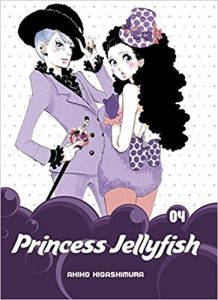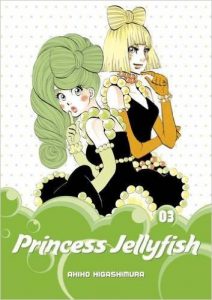By Akiko Higashimura. Released in Japan in two separate volumes as “Kuragehime” by Kodansha, serialization ongoing in the magazine Kiss. Released in North America by Kodansha Comics. Translated by Sarah Alys Lindholm.
I realize that it is coincidence, but frequently the volume of Princess Jellyfish that I am reading is there to answer the questions and concerns I mentioned in my review of the previous volume. Last time I talked about wanting Kuranosuke to have to deal with consequences and be thrown off his game more, and I also mentioned the market for the jellyfish dresses being upscale and not for people like Tsukimi. Lo and behold, in this volume Kuranosuke is not only dealing with once again being told how hard it is to be a successful clothing maker in the world today, but also has to stand by and suck it up as Shu and Tsukimi get close enough to start dating, although given the two of them are still talking at cross-purposes a bit, I’m not sure if that’s going to be an endgame. And yeah, what fashion would Amars, the most unfashionable, wear?
Amars is actually pretty impressive here; for all that they may whine and complain a lot (especially Mayaya), they’re very much involved in both saving the apartment complex and getting the jellyfish brand out there. And the biggest worry of the book, how they will react when they hear that Tsukimi and Shu are going out, also turns out to less of a crisis than expected – Shu is, after all, the son of a politician and being groomed for greater things. Ergo, a political marriage would be a godsend for the rest of Amars. Of course, as a reader I’m not entirely convinced that Tsukimi would make a very good politician’s wife. As for the dresses, now that we’ve established the high-end dresses, we need cheaper stuff for the casual buyer. But what if the casual buyer is Amars? Would they wear this stuff? Not a chance. So.. what WOULD they willingly buy?
This volume features not one, not two, but THREE characters slowly realizing that they’ve fallen in love, each with different impact. Tsukimi is the most obvious, adn I’m still not sure it’s sunk in for her, or even if she grasps what it means going forward. The proposal certainly hasn’t sunk in. Inari, meanwhile, hears from Shu that he has a “fiancee” at the apartments, and is horrified not just at the idea that one of those girls (she doesn’t know which one) could have bewitched him but that it hurts her enough for her to realize that she has genuine feelings of love for Shu as well. As for Kuranosuke, I think he’s the furthest behind, as he’s not really admitting to himself at all how he really feels about Tsukimi even as he distances himself by saying he’s the “sorcerer” who placed a spell on her to make her a “princess”. Which is all very well and good, but sounds pretty cowardly to me.
They just announced the manga is wrapping up in Japan this fall, though we still have a few omnibuses to go to catch up. In the meantime, it gets better with each volume, and if you haven’t picked it up yet you should.



